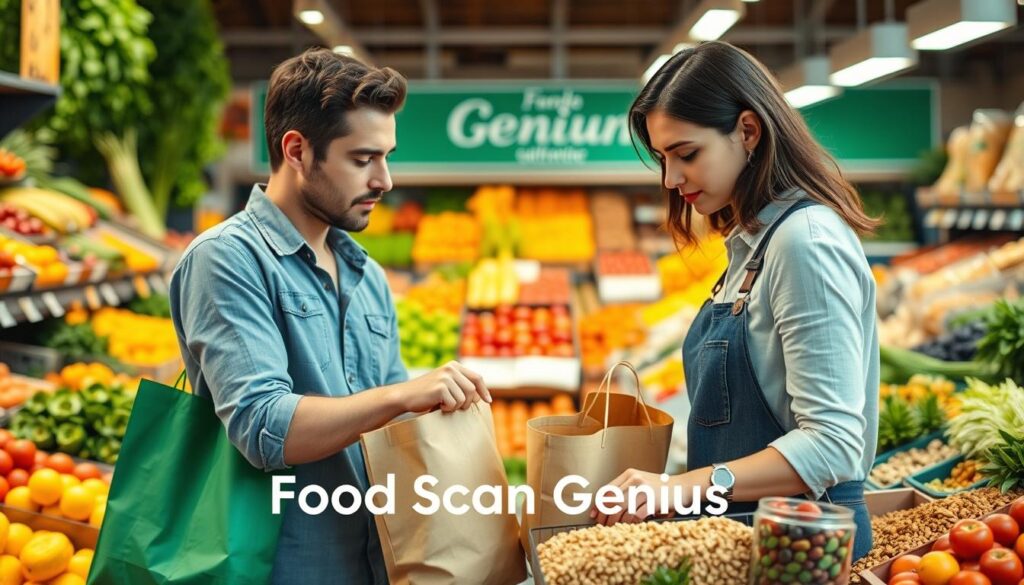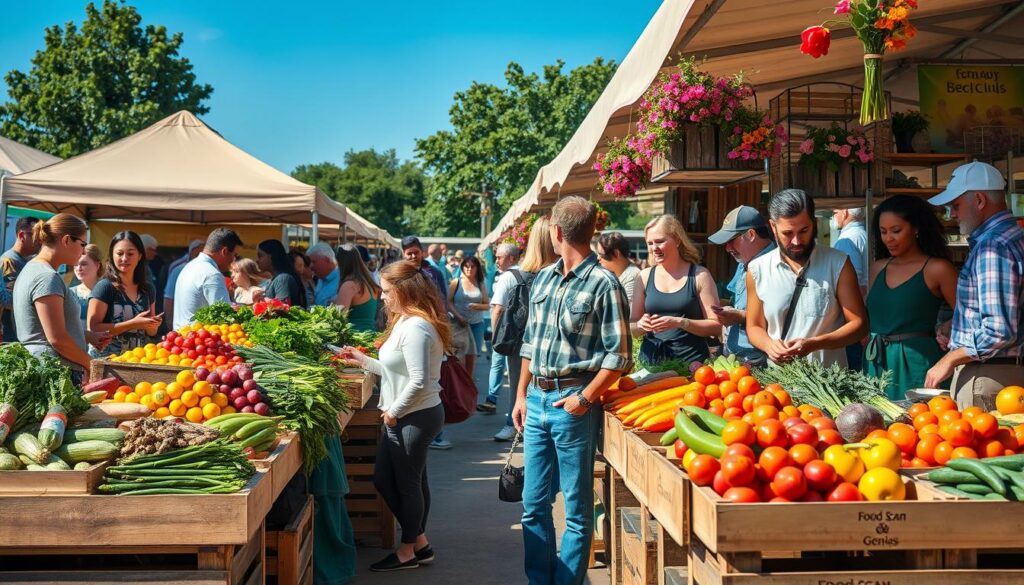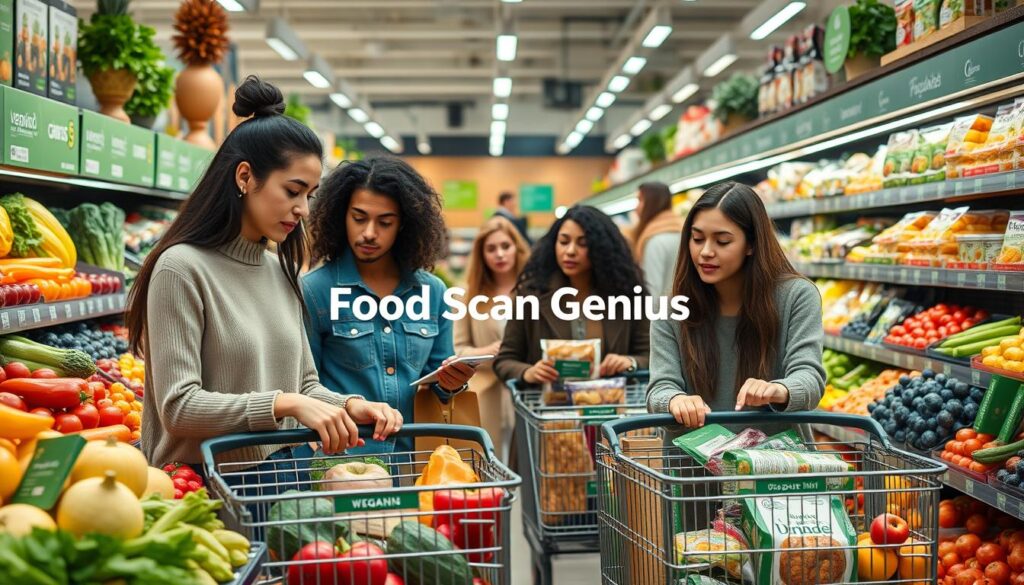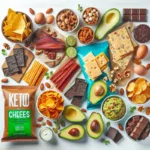As a passionate vegan, I know grocery shopping can be tough. Finding vegan-friendly items can seem like a big challenge. But don’t worry, I’m here to help. We’ll explore the world of vegan grocery shopping together.
We’ll find hidden gems, learn to shop smart, and make delicious, cruelty-free meals. These meals will nourish your body and soul.
Stores like Whole Foods, Trader Joe’s, and Kroger have lots of vegan products1. The FDA makes sure labels show major allergens like milk and soy1. More stores now have special sections for vegan foods.
Key Takeaways
- Major grocery stores offer a wide variety of vegan products, from essentials to specialty items.
- The FDA requires food labels to list major allergens, helping vegans identify suitable products.
- Stores are increasingly catering to the vegan community with dedicated sections for plant-based foods.
- The Food Scan Genius app can assist with identifying vegan-friendly items while shopping.
- Vegan grocery shopping is becoming more accessible, with a growing selection of cruelty-free products.
And there’s the Food Scan Genius app! It’s the top AI assistant for shoppers with food allergies and dietary needs. It makes finding vegan products easy. Just scan and see if products are vegan-friendly.
So, let’s start our vegan shopping adventure. We’ll explore new plant-based foods and fill our pantries with tasty, healthy, and compassionate items. Get ready for a unique vegan shopping journey!
Understanding a Vegan Diet
Choosing a vegan lifestyle means avoiding all animal products like meat, dairy, eggs, and honey2. At the core of a vegan diet are plant-based foods. These foods are packed with nutrients needed for a healthy life.
What Does Vegan Mean?
“Vegan” is about living without animal exploitation for food, clothes, or anything else3. Vegans make choices that are kind to animals and the planet. They avoid products made from animals.
Key Components of a Vegan Diet
A good vegan diet includes lots of fruits, veggies, grains, legumes, nuts, and seeds2. These foods give you the proteins, carbs, fats, vitamins, and minerals you need3.
To keep your diet balanced, eat a variety of plant-based proteins2:
- Nuts: almonds, walnuts, pecans, pistachios, etc.
- Seeds: pumpkin, sunflower, etc.
- Chickpeas, black beans, pinto beans
- Lentils
- Plant-based protein powder
Grains like2quinoa, rice, millet, barley, and oats are also key. They give you complex carbs and fiber. You can also add vegan-friendly packaged foods like granola and vegan mac & cheese to your diet2.
To make your meals tasty, keep a vegan pantry stocked with2olive oil, coconut oil, rice vinegar, balsamic vinegar, liquid smoke, and turmeric. Enjoy snacks like dried fruit, popcorn, coconut flakes, and dark chocolate in small amounts2.
Choosing veganism is a personal choice for many3. It’s about being kind to animals and the planet. By knowing what a vegan diet includes, you can start a journey towards a better life.
Essential Vegan Pantry Staples
Having a well-stocked vegan pantry makes cooking easy and fun. It ensures you have all the plant-based essentials you need. From grains and legumes to spices and oils, these items are the heart of a healthy, sustainable diet4.
Grains and Legumes
Whole grains like quinoa, brown rice, and oats give you energy and keep you full4. Legumes, such as beans and lentils, are packed with protein and nutrients5. Trying different grains and legumes can add exciting flavors and textures to your meals.
Spices and Seasonings
A good spice cabinet can make any dish special. Nutritional yeast, turmeric, and garlic powder can turn simple foods into delicious meals4. Coconut aminos, tahini, and vegan Worcestershire sauce add depth to your cooking4.
Plant-Based Oils and Sauces
Plant-based oils like olive, coconut, and avocado oil are great for cooking and adding flavor5. Sauces like tamari and vegan mayonnaise can make any meal better4. Having a variety of oils and sauces means you can make tasty, satisfying vegan meals anytime.
Embracing a vegan lifestyle doesn’t mean sacrificing flavor or creativity in the kitchen. With the right pantry staples, the culinary possibilities are endless!”
With these essential vegan pantry items, you can make delicious, healthy meals that fit your lifestyle45.
| Grains | Legumes | Spices & Seasonings | Oils & Sauces |
|---|---|---|---|
|
|
|
|
Having these vegan essentials in your pantry makes cooking easy and fun. You can make a wide variety of healthy, tasty meals with ease45.
Fresh Produce: What to Look For
Fresh produce is key to a vegan diet. Look for fruits with bright colors, firm textures, and a sweet smell. Favorites include bananas, berries, apples, and citrus fruits like oranges and grapefruits6.
Fruits: A Sweet Selection
Choose seasonal and organic fruits for the best taste and nutrition. Berries like blueberries, raspberries, and blackberries are packed with antioxidants. Bananas and apples add natural sweetness. Citrus fruits like oranges and grapefruits add a refreshing touch to vegan dishes and drinks6.
Vegetables: How to Choose Fresh Ones
For veggies, pick crisp, colorful ones without spots. Leafy greens like kale, spinach, and romaine lettuce are great for salads and smoothies. Cruciferous veggies like broccoli, cauliflower, and Brussels sprouts are nutrient-rich. Root veggies like carrots, beets, and potatoes offer complex carbs and fiber6.
Seasonal produce tastes better and is more nutritious. It also supports sustainable farming. By choosing fresh, in-season fruits and veggies, you can make tasty, healthy vegan meals6.
| Fruits | Vegetables |
|---|---|
| Apples, Pears, Bananas, Berries, Citrus Fruits, Melons | Broccoli, Carrots, Cucumbers, Tomatoes, Leafy Greens, Squash |
When buying produce, look for bright colors, firm textures, and freshness. Adding a variety of seasonal, organic fruits and veggies to your diet makes for a delicious and healthy vegan experience67.
Tips for Budget-Friendly Vegan Shopping
Living a vegan lifestyle doesn’t have to cost a lot. You can eat a wide variety of healthy, vegan foods without spending too much. Here are some tips to help you save money when you shop for vegan groceries.
Utilizing Seasonal Produce
Buying seasonal produce is a great way to save money8. Produce in season is cheaper and tastes better. Plan your meals with what’s fresh and local to enjoy tasty, affordable vegan food all year.
Comparing Store Prices
It’s smart to compare prices at different stores9. Stores like The Grocery Outlet have vegan products at big discounts, sometimes up to 80% off. Buying nuts, seeds, and dried goods in bulk also saves money compared to buying them pre-packaged10.
For fresh produce10, try local stands or farmers’ markets for better prices. And check the clearance sections of stores for vegan items that are close to expiring but still good to eat8.
Shopping around and comparing prices can help you save a lot on vegan groceries9. Planning your meals and stocking up on pantry items also keeps your budget in check while enjoying tasty vegan meals8.
With a bit of creativity and an eye for deals, you can make vegan shopping affordable. So, let’s start shopping and enjoy the savings8910!
Navigating Vegan Labels and Claims
Figuring out vegan labels and claims can seem tough. But don’t worry, we’re here to help. Look for the Sunflower Trademark, Yellow circular V-Label, and The Certified Vegan Logo on products11. But, some fake animal products might only have the vegetarian V-label, not vegan11.
Understanding Ingredients
It’s key to read ingredient lists for vegan products. Food packaging must highlight allergens in bold, like “Contains egg/milk/dairy”11. Some allergens, like “Contains nuts/gluten/wheat/soy/celery”, are okay for vegans11.
Watch out for albumen/albumin, casein, collagen, gelatine, lard/tallow, lactose, pepsin, and vitamin D311. Glycerine, lactic acid, and stearic acid might come from animals or plants. It’s best to check with the maker11.
Differentiating Between “Vegan” and “Plant-Based”
“Vegan” and “plant-based” labels mean different things. “Plant-based” just means it’s made from plants, but it might still have animal products12. Companies might use “certified plant-based”, “vegan-certified”, or “vegan friendly” to clarify12.
The Planted-Based Foods Association uses a “Certified Plant-Based” symbol. This ensures the product is 100% plant-based and free from animal products12.
Use the Food Scan Genius app to check if products are vegan and safe from allergens11. With knowledge and the right tools, you’ll navigate vegan products easily.
| Vegan Certification | Description |
|---|---|
| The Vegan Trademark | The oldest and most recognized vegan logo, owned and regulated by The Vegan Society13. |
| The V-Label Trademark | A standardized European vegan and vegetarian label, managed by the European Vegetarian Union13. |
| The ‘Vegan Approved’ Trademark | A vegan certification program operated by Vegan Action in the United States13. |
| The Certified Vegan Logo | A vegan certification program operated by Vegan Action in the United States13. |
| The “Vegan Founded” Trademark | A vegan trademark that indicates the company behind the product is vegan-owned13. |
Navigating the world of vegan labels and claims can feel like solving a complex puzzle, but with a little knowledge and the right tools, you can become a pro at spotting true vegan products.
Meal Planning for a Successful Week
Effective vegan meal planning is key to a balanced diet and easier grocery shopping. A weekly menu with various nutrient-rich ingredients makes meals tasty and nutritious. This ensures your body gets the nutrients it needs.
Creating a Balanced Vegan Menu
Include protein-rich foods like legumes, tofu, and tempeh in your meals14. This keeps you full and energized. Also, add colorful fruits and vegetables for vitamins, minerals, and antioxidants14.
Efficient Grocery Lists
Making a detailed grocery list is crucial for a successful vegan meal plan14. Create a list based on your menu, organizing by store section14. This saves time and reduces waste by only buying what you need.
| Vegan Meal Planning Benefits | Key Statistics |
|---|---|
| Balanced plant-based diet | 14 The vegan meal plan is designed for one person over a 7-day period, allowing for adjustments based on the number of individuals it caters to. |
| Streamlined grocery shopping | 14 The shopping list is meticulously crafted to match the quantities required for each recipe, ensuring streamlined grocery shopping and minimum food wastage. |
| Time-saving | 15 More than 52 hours saved through proper meal planning. |
| Cost-effective | 15 Savings up to 59% on grocery bill. |
Spending a bit of time on meal planning and grocery lists can save you time and money15. It’s good for your health, wallet, and the planet.

“The vegan Tofu Caesar Wrap is a lunch option with high satisfaction as it was mentioned ‘you won’t regret it.'”15
Whether you’re new to veganism or experienced, good meal planning and shopping can make your week easier16. It helps you stay on track with a healthy, balanced diet.
Exploring Vegan Alternatives
The vegan lifestyle is growing fast, changing what we find in stores. Now, we have many plant-based options for every need. From creamy non-dairy products to tasty meat substitutes, there’s a lot to choose from17.
Dairy-Free Options
There are many more vegan dairy alternatives now. You can find plant-based milks like almond, soy, and oat. These milks are good for drinking, cooking, and baking17.
They also have lots of vitamins, minerals, and protein18. Vegan cheese, yogurt, and ice cream are also plentiful. They meet many tastes and needs17.
Meat Substitutes and Proteins
Vegan meat alternatives are exciting, even for meat lovers. Tofu, tempeh, and seitan are classics for many recipes17. Newer options like plant-based burgers and sausages are also popular17.
These alternatives are tasty and full of protein. They make vegan eating easy and convenient18.
But, don’t forget about whole foods like legumes, nuts, and seeds. They’re great for protein too18.
Embracing a vegan diet doesn’t mean sacrificing the flavors and textures you love. The world of plant-based alternatives has evolved to offer an abundance of delicious and nutritious choices.”
Looking for a creamy non-dairy option or a meat substitute? The vegan grocery scene has you covered. Exploring these options can make your vegan lifestyle even better17.
Shopping at Local Farmers’ Markets
As vegans, we have a chance to help our local farmers and get the freshest produce. Visiting farmers’ markets is a great way to do this19.
These markets pop up in summer, filled with local fruits, veggies, and more19. You’ll find juicy tomatoes, sweet peaches, and more. It’s a feast for the eyes and taste buds19.
Benefits of Buying Local
Shopping at farmers’ markets gives you fresh food and supports sustainable farming. You avoid long transportation, which is good for the planet19. You also find unique, heirloom fruits and veggies not in regular stores19.
How to Support Sustainable Farming
Talking to farmers at the market is rewarding. Ask them about their methods and how to use new foods19. Some markets offer CSA programs for regular, local veggies all year19.
Buying from local markets helps the environment and supports farmers. It’s a simple way to make a big difference19. So, use your reusable bags and enjoy the local flavors. Your taste buds and the planet will appreciate it19.

“Buying local produce is one of the most impactful ways we can support sustainable agriculture and reduce our environmental footprint as vegans.”
Eco-Friendly Shopping Practices
We know how key it is to match our vegan lifestyle with green shopping habits. Making eco-conscious choices helps us lessen our environmental footprint. It also supports companies that care about ethics. Let’s see how we can make a difference, one shopping trip at a time.
Reducing Plastic Waste
One simple way to cut down on plastic waste is by using reusable bags, produce bags, and containers when we shop20. This small action greatly reduces single-use plastics that harm our oceans and landfills. We should also pick products with less packaging or those that can be recycled.
Choosing Sustainable Brands
Supporting brands that focus on sustainability and ethics is crucial when buying vegan groceries21. Look for labels like Fair Trade, Rainforest Alliance, or B Corp. These show a company’s dedication to being good for people and the planet. Choosing package-free items, like loose fruits and veggies, is another way to cut down on waste.
By adopting these green shopping habits, we ensure our food choices are good for us and the planet2021. Together, we can help make the world a greener place. Our daily shopping decisions can have a big, lasting impact.
FAQ
What does it mean to be vegan?
What are some essential vegan pantry staples?
How can I find fresh, seasonal produce as a vegan?
What are some tips for budget-friendly vegan shopping?
How can I identify vegan products when shopping?
How can I plan meals to maintain a balanced vegan diet?
What are some good vegan alternatives to traditional dairy and meat products?
How can I support sustainable and eco-friendly grocery shopping as a vegan?
Source Links
- The Ultimate Vegan Grocery Shopping List
- Vegan Grocery List for Beginners
- Vegan Shopping List: Ultimate Guide For Beginners | Myvegan
- How To Stock a Vegan Pantry (Full Ingredient List!)
- Vegan Pantry & Kitchen Essentials – The Simple Veganista
- Building a Healthy Vegan Grocery List
- The complete guide to plant-based grocery shopping for beginners
- How To Be Vegan on a Budget: Cheap Vegan Grocery List – GenV
- Vegan on a Budget + Grocery Shopping Tips & Tricks — Love By Plants
- A Complete Guide To Vegan Grocery Shopping On A Budget
- How to Read Labels as a Vegan – A Step-by-Step Guide – Sarahs Vegan Guide
- Vegan label reading guide
- Guide to Reading Food Labels as a Vegan | Exploring Vegan
- Easy 7-Day Vegan Meal Plan with Shopping List
- Free 7-Day Vegan Meal Plan!
- 1-Month Vegan Meal Plan + Grocery List
- Vegan Grocery List: Meat Alternatives, Pantry Essentials & More | Whole Foods Market
- Vegan Grocery List for Shopping: Ultimate Vegan Food List
- How You Should Be Shopping At Your Local Farmers’ Market
- Guide to Vegan Grocery Shopping
- Top 10 Eco-Friendly Grocery Shopping Tips – ECOS®






2 Comments
[…] you’ve ever asked, “Is this really vegan?” while grocery shopping, this guide is for you. In this article, we compare the best vegan food scanner apps in 2025 and explain why […]
[…] Oats deserve prime real estate in your vegan breakfast routine. When stored properly, these versatile grains maintain their freshness for up to 30 years [36], making them an essential foundation for your vegan grocery list. […]